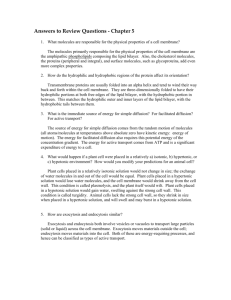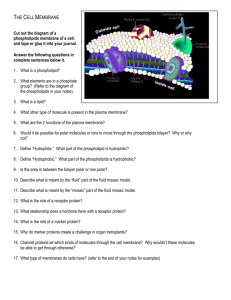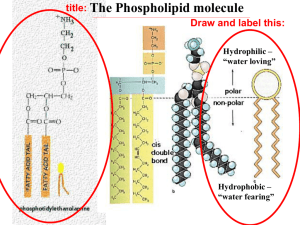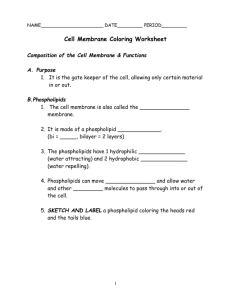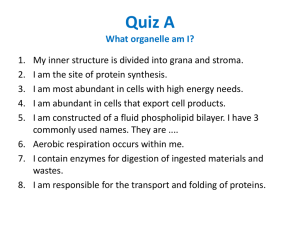Cell Membrane Coloring Page Name: Following the directions in the
advertisement
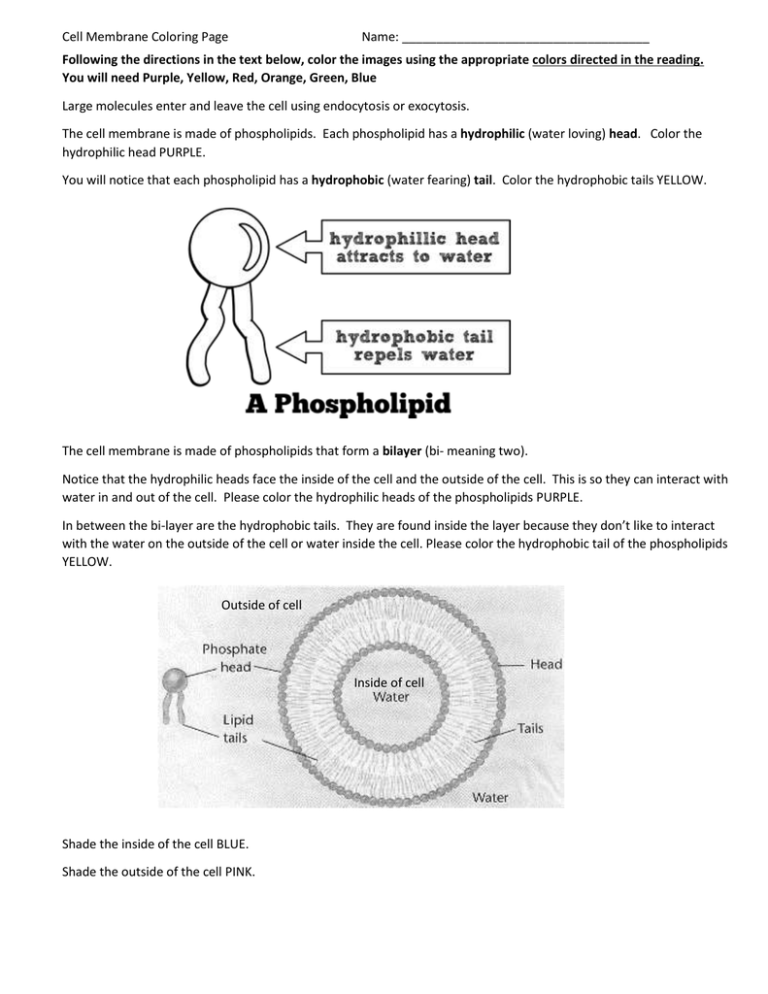
Cell Membrane Coloring Page Name: ____________________________________ Following the directions in the text below, color the images using the appropriate colors directed in the reading. You will need Purple, Yellow, Red, Orange, Green, Blue Large molecules enter and leave the cell using endocytosis or exocytosis. The cell membrane is made of phospholipids. Each phospholipid has a hydrophilic (water loving) head. Color the hydrophilic head PURPLE. You will notice that each phospholipid has a hydrophobic (water fearing) tail. Color the hydrophobic tails YELLOW. The cell membrane is made of phospholipids that form a bilayer (bi- meaning two). Notice that the hydrophilic heads face the inside of the cell and the outside of the cell. This is so they can interact with water in and out of the cell. Please color the hydrophilic heads of the phospholipids PURPLE. In between the bi-layer are the hydrophobic tails. They are found inside the layer because they don’t like to interact with the water on the outside of the cell or water inside the cell. Please color the hydrophobic tail of the phospholipids YELLOW. Outside of cell Inside of cell Shade the inside of the cell BLUE. Shade the outside of the cell PINK. Cell Membrane Coloring Page Name: ____________________________________ Endocytosis is the movement of large molecules into a cell. These molecules are too large to pass through the cell membrane or through protein channels. Specifically, cells use phagocytosis to take in a large molecule. Amoebas use this method to acquire food. Pinocytosis is similar but instead of a large molecule, the cell takes in many small particles or solutes dissolved in liquid. 1. 2. 3. 4. 5. Color the hydrophilic heads of the phospholipid bilayer PURPLE. Color the hydrophobic tails of the phospholipid bilayer YELLOW. Shade the outside of the cell in PINK. Shade the inside of the cell in BLUE. The first step in endocytosis is large molecules gathering on the outside of the cell membrane. Color the area that represents the first step in GREEN. 6. The second step of endocytosis is that the cell membrane begins to pinch together to form a vesicle around the large molecules. Color the area that represents the second step ORANGE. 7. The third step of endocytosis occurs when the cell membrane pinches together completely, the newly formed vesicle detaches and the cell membrane re-seals itself. Color the area that represents the third step in RED. Exocytosis is the movement of large molecules out of a cell. These molecules are too large to pass through the cell membrane or through protein channels. 1. 2. 3. 4. 5. Color the hydrophilic heads of the phospholipid bilayer PURPLE. Color the hydrophobic tails of the phospholipid bilayer YELLOW. Shade the outside of the cell in PINK. Shade the inside of the cell in BLUE. The first step in exocytosis is large molecules bound in vesicles from the cell (from Golgi complex) fuse or attach to the cell membrane from the inside of the cell. Color the area that represents the first step in GREEN. 6. The second step of exocytosis is that the cell membrane is now fused to the vesicle and then it begins to open to the outside surrounding the cell. Color the area that represents the second step ORANGE. 7. The third step of exocytosis occurs when the large molecules are released to the outside of the cell and the phospholipid bilayer that was once part of the vesicle is now part of the cell membrane. Color the area that represents the third step in RED.
